Physella" heterostropha pomilia, hendersoni
> Habitat & Distribution
Populations of P. pomilia are widespread but patchily-distributed on the margins of slow-moving rivers in the lower piedmont and coastal plain across the southern United States from Maryland to Florida and west across Alabama and Tennessee at least as far as Kansas, especially in springs and rich waters of high quality. The range of P. pomilia may extend further, but longtime confusion with Physa acuta has rendered the interior distributions of both very poorly documented.
Snails are typically found on emergent vegetation and debris in quiet backwaters. Populations are typically sparse - never in the high densities characteristic of P. acuta. FWGNA incidence rank I-4.
> Ecology & Life History
Our laboratory cultures of P. pomilia reach maturity only 5 6 weeks post hatch, and shell length of only 5 6 mm. This is about two weeks earlier and 1 2 mm smaller than typical P. acuta raised under similar conditions (Dillon et al. 2007).
> Taxonomy & Systematics
Although outwardly similar to P. acuta, adult Physa pomilia bear a unique penial morphology that George Te (1978) described as "type-bc," intermediate between those of Physa acuta and Physa gyrina. Our laboratory mating experiments (Dillon et al. 2007) have returned evidence of both premating and postmating reproductive isolation between pomilia, acuta, and gyrina as well. All three groups were depicted as distinct in the molecular phylogenies of Wethington (2004a) and Wethington & Lydeard (2007).
The taxonomic history of P. pomilia is a long and checkered one (Wethington et al. 2009). Conrad originally described P. pomilia from Randons Creek near Claiborne, Alabama. Clench (1925) described a subspecies, P. pomilia hendersoni, from Yemassee, Beaufort County, South Carolina. George Te (1978) synonymized pomilia under heterostropha and raised hendersoni to the rank of full species. It was this Te classification of the Physidae that was adopted by Burch in his influential (1980, 1982) monograph of the North American freshwater snails.
Dillon et al. (2002) showed, however, that P. heterostropha is a synonym of the cosmopolitan P. acuta. And the mate choice tests and no-choice breeding studies of Dillon, Robinson, and Wethington (2007) confirmed Clench s (1925) initial impression that hendersoni populations from Yemassee are reproductively isolated from acuta/heterostropha but not reproductively isolated from P. pomilia collected at its Alabama type locality. Clench s hendersoni is apparently a simple synonym of Conrad s pomilia.
For notes regarding the placement of pomilia in the genus Physa, rather than Physella, see my essay of 12Oct07 below.
> Maps and Supplementary Resources
- Physa pomilia distribution in Atlantic drainages (2023)
- Physa distribution in Georgia and the Florida panhandle (2025)
- Physa distribution in the Tennessee/Cumberland (2022)
- Physa pomilia in The Great Plains (2024)
> Essays
- The phylogenetic analysis of Wethington & Lydeard prompted me to review The Classification of the Physidae in my post of 12Oct07.
- Physa pomilia received a passing mention in my 7Apr10 essay "TRUE CONFESSIONS: I described a new species."
- The Dillon et al. (2011) paper on the evolution of reproductive isolation in Physa served as a jumping-off point for my blog post of 12July11, "What is a Species Tree?"
- For an historical perspective on the classification of the Physidae, see my three part series on the life and work of George A. Te: To Identify a Physa 1971, To Identify a Physa 1975, and To Identify a Physa 1978 plus the more personal To Identify a Physa 1989 and To Identify a Physa 2000.
- See my post of 26Sept14 for good, comparative figures illustrating "The egg masses of freshwater pulmonate snails."
> References
Burch, J., and J. Tottenham (1980) North American freshwater snails: species list, ranges, and illustrations. Walkerana 3: 1-215.
Burch, J. B. (1982) North American freshwater snails: Identification keys, generic synonymy, supplemental notes, glossary, references, index. Walkerana 4: 216 - 365.
Burgarella, C. et al. (2015) Molecular evolution of freshwater snails with contrasting mating systems. Mol. Biol. Evol. 32(9): 2403 - 2416.
Clench, W. J. (1925) Notes on the genus Physa with descriptions of three new subspecies. Occas. Pprs. Mus. Zool. Univ. Mich. 161: 1 10.
Dillon, R. T., J. D. Robinson, and A. R. Wethington (2007) Empirical estimates of reproductive isolation between the freshwater pulmonates Physa acuta, P. pomilia, and P. hendersoni. Malacologia 49: 283-292. [PDF]
Dillon, R. T., A. R. Wethington, and C. Lydeard (2011) The evolution of reproductive isolation in a simultaneous hermaphrodite, the freshwater snail Physa. BMC Evolutionary Biology 11:144. [PDF] [html]
Dillon, R. T., Jr., A. R. Wethington, J. M. Rhett, and T. P. Smith (2002) Populations of the European freshwater pulmonate Physa acuta are not reproductively isolated from American Physa heterostropha or Physa integra. Invert. Biol. 121(3):226-234. [PDF]
Te, G. A. (1975) Michigan Physidae, with systematic notes on Physella and Physodon (Basommatophora: Pulmonata). Malacological Review 8(1-2):7-30.
Te, G. A. (1978) The systematics of the family Physidae (Basommatophora: Pulmonata). Ph.D. Dissertation, University of Michigan, pp. 325.
Te, G. A. (1980) New classification for the family Physidae (Pulmonata: Basommatophora). Arch. Moll. 110:179-184.
Wethington, A. R. (2004a) Phylogeny, taxonomy, and evolution of reproductive isolation in Physa (Pulmonata: Physidae) Ph.D. dissertation, University of Alabama, Tuscaloosa.
Wethington, A. R. (2004b) Family Physidae. A supplement to the workbook accompanying the FMCS Freshwater Identification Workshop, University of Alabama, Tuscaloosa. 24 pp. [PDF]
Wethington, A. R. & C. Lydeard (2007) A molecular phylogeny of Physidae (Gastropoda: Basommatophora) based on mitochondrial DNA sequences. J. Molluscan Stud. 73: 241 - 257. [PDF]
Wethington, A.R., J. Wise & R. T. Dillon, Jr. (2009) Genetic and morphological characterization of the Physidae of South Carolina, with description of a new species. Nautilus 123: 282-292. [PDF]








